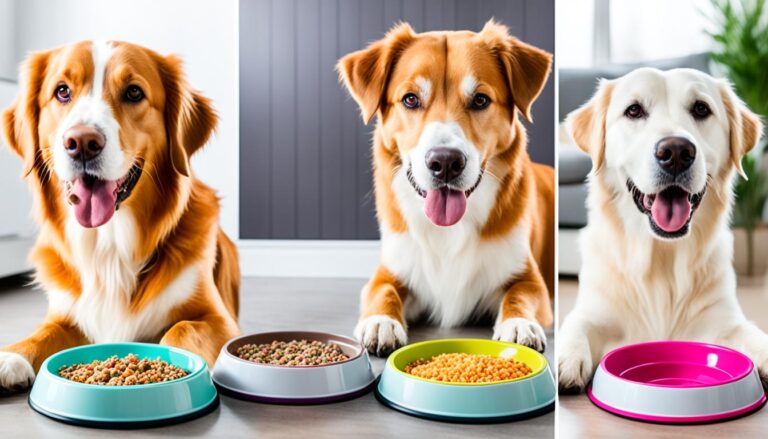Transitioning Your German Shepherd to Adult Food
Did you know that the timing of switching your German Shepherd from puppy to adult food can significantly impact their lifelong wellness? Nutrition plays a crucial role in their growth and development, and making the transition at the right time is essential for their health.
German Shepherds have specific nutritional needs that change as they mature. Puppy and adult dog foods differ in their macronutrient and mineral composition, with puppy foods containing higher levels of protein, fat, calcium, and phosphorous to support their rapid growth.
Knowing when to switch to adult food is crucial to avoid potential health issues. Transitioning too early or too late can lead to problems such as obesity or growth abnormalities. So, how do you determine the best time to make the switch for your furry friend?
In the following sections, we’ll explore the optimal time to transition your German Shepherd to adult food, as well as provide tips for a seamless and successful change. By understanding the key factors and considerations, you can ensure that your German Shepherd receives the nutrition they need to thrive throughout their life.
The Optimal Time to Switch to Adult Food for German Shepherds
Switching your German Shepherd puppy from a puppy to adult food is an important step in their nutritional journey. The timing of this transition depends on various factors, including their breed size and individual growth rate.
When it comes to smaller breeds like Chihuahuas, Yorkshire Terriers, and Pugs, they tend to reach their adult size sooner. For these breeds, it’s typically recommended to switch them to adult food around 9-10 months of age.
Medium-sized breeds like English Springer Spaniels and Australian Shepherds take a bit longer to reach their adult size. They usually reach their full size between 12-14 months. Therefore, transitioning them to adult food at this time is generally appropriate.
Now, let’s talk about our beloved German Shepherds. Being a large breed, German Shepherds have a longer growth period compared to smaller and medium-sized breeds. They typically reach their adult size between 14-24 months. To ensure their proper growth and development, it is crucial to keep them on puppy food until they are fully mature.
However, it’s important to note that highly active German Shepherds may benefit from staying on puppy food for longer. The extra protein and calories in puppy food can help support their energy needs. Additionally, the timing of the switch may be influenced by other factors such as spaying/neutering, which can affect calorie requirements.
Switching too early or too late can have negative consequences, including the risk of obesity or growth abnormalities. To determine the best time to switch, it’s always recommended to consult with your veterinarian. They can assess your German Shepherd’s specific needs and provide personalized guidance for a smooth transition to adult food.
Remember, every dog is unique, and their growth rate may vary. It’s essential to monitor your German Shepherd’s growth progress and consult with a professional to ensure they receive the appropriate nutrition at the right time.
Transitioning Your German Shepherd to Adult Food
When transitioning your German Shepherd to adult food, it’s crucial to do it gradually. Abruptly changing their diet can lead to digestive issues and discomfort. Here’s a step-by-step guide to a seamless transition:
- Start by mixing a small amount of the adult food with their current puppy food.
- Gradually increase the proportion of adult food over the course of a week or two.
- Observe your German Shepherd’s body condition and adjust the portion sizes accordingly, focusing on their shape and weight rather than the amount of food they consume.
- Note any changes in appetite and stools during the transition period. Loose stools or a sudden decrease in appetite may indicate the need to adjust the transition pace or seek guidance from your veterinarian.
When selecting adult food for your German Shepherd, opt for a reputable brand that meets AAFCO standards for complete and balanced nutrition. Look for essential nutrients like protein, fat, minerals, and vitamins to support their overall health and wellbeing.
Feeding Your Adult German Shepherd
Once your German Shepherd has made the switch to adult food, it’s important to establish a consistent feeding schedule. Most adult dogs thrive on two meals a day. However, individual needs may vary based on factors like activity level and overall health.
Monitor your dog’s appetite and adjust the portion sizes accordingly. Keep in mind that adult dog food is typically less calorie-dense than puppy food, so your German Shepherd may require slightly smaller servings or less food per meal.
Ensure access to fresh water at all times, and regularly check your German Shepherd’s overall health and well-being to ensure they are thriving on their new diet.
| Breed Size | Optimal Time to Switch to Adult Food |
|---|---|
| Smaller Breeds (e.g., Chihuahuas, Yorkshire Terriers, Pugs) | 9-10 months |
| Medium-Sized Breeds (e.g., English Springer Spaniels, Australian Shepherds) | 12-14 months |
| Large Breeds (e.g., German Shepherds) | 14-24 months |
Tips for a Seamless Transition to Adult Food for German Shepherds
When transitioning your German Shepherd to adult dog food, it’s important to do so gradually to avoid causing any gastrointestinal issues. Start by mixing a small amount of the adult food with the puppy food and gradually increase the proportion of adult food over a week or two.
During the transition, it’s crucial to watch your dog’s body condition and adjust portion sizes accordingly. Instead of relying solely on the amount of food they consume, observe their body shape and weight. Some German Shepherds may need fewer servings or less food per meal once they switch to adult food, as it is typically less calorie-dense than puppy food.
Monitor your dog’s appetite and stools during the transition period. Loose stools or a sudden decrease in appetite may indicate a need to adjust the transition pace or consult with a veterinarian. Additionally, consider factors like breed size, activity level, and overall health when determining the appropriate feeding schedule for your adult German Shepherd.
When selecting adult dog food, prioritize high-quality options that meet AAFCO standards for complete and balanced nutrition. Take into account any additional dietary requirements or sensitivities your German Shepherd may have. Provide fresh water at all times and continue to monitor your dog’s overall health and well-being during the transition period and beyond.
FAQ
When is the best time to switch my German Shepherd to adult dog food?
The optimal time to switch a German Shepherd puppy to adult dog food depends on factors like breed size and individual growth rate. Smaller breeds, such as Chihuahuas, Yorkshire Terriers, and Pugs, reach adult size sooner and can transition to adult food around 9-10 months of age. Medium-sized breeds, like English Springer Spaniels and Australian Shepherds, reach adult size between 12-14 months and can switch to adult food around that time. Large breeds, including German Shepherds, reach adult size between 14-24 months and should stay on puppy food until they are fully mature to ensure proper growth and development of their larger skeletons. Highly active dogs may benefit from staying on puppy food longer for the extra protein and calories to support their energy needs. It is important to consider spaying/neutering as it can affect the timing of the switch due to changes in calorie requirements. Switching too early or too late can have negative consequences, such as obesity or growth abnormalities. Consulting with a veterinarian can help determine the best time to switch based on the specific needs of your German Shepherd.
How should I transition my German Shepherd to adult dog food?
When transitioning a German Shepherd to adult dog food, it is important to do it gradually to avoid causing any gastrointestinal issues. Start by mixing a small amount of the adult food with the puppy food and gradually increase the proportion of adult food over a week or two. Watch your dog’s body condition and adjust the portion sizes accordingly. This means observing their body shape and weight rather than relying solely on the amount of food they consume. Some German Shepherds may need fewer servings or less food per meal once they switch to adult food, as it is typically less calorie-dense than puppy food. Monitor your dog’s appetite and stools during the transition period. Loose stools or a sudden decrease in appetite may indicate a need to adjust the transition pace or consult with a veterinarian.
What should I consider when selecting adult dog food for my German Shepherd?
Prioritize high-quality adult dog food that meets AAFCO standards for complete and balanced nutrition. Look for essential nutrients like protein, fat, minerals, and vitamins, and consider additional ingredients based on your dog’s specific requirements. Choose a reputable brand and consider whether dry or wet food is best for your German Shepherd based on their preferences and needs. If your German Shepherd has any dietary sensitivities or special health considerations, consult with a veterinarian for tailored recommendations.
How should I adjust the feeding schedule when my German Shepherd transitions to adult food?
Feeding schedules may change when transitioning to adult food. Most dogs typically eat two meals a day once they reach adulthood. Consider factors like breed size, activity level, and overall health when determining the appropriate feeding schedule for your adult German Shepherd. Monitor your dog’s appetite and body condition to ensure they are receiving the right amount of food for their individual needs.
What should I monitor during the transition to adult food for my German Shepherd?
During the transition period, monitor your dog’s overall health and well-being. Keep an eye on their appetite, stools, and body condition to ensure the transition to adult food is going smoothly. Loose stools or a sudden decrease in appetite may indicate a need to adjust the transition pace or consult with a veterinarian.
How can I ensure my German Shepherd’s nutrition needs are met with adult dog food?
To ensure your German Shepherd’s nutrition needs are met with adult dog food, select a high-quality brand that meets AAFCO standards for complete and balanced nutrition. Consider any additional dietary requirements or sensitivities your German Shepherd may have and choose a formula that addresses those needs. Regularly monitor your dog’s weight, body condition, and overall health to ensure they are maintaining optimal well-being with their adult food.







